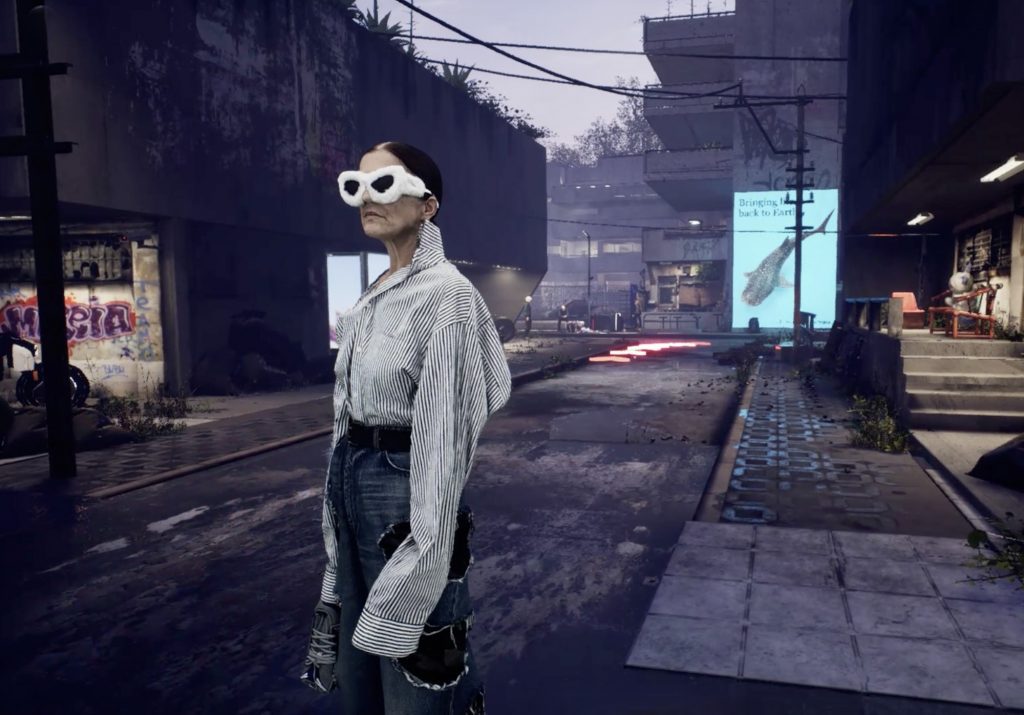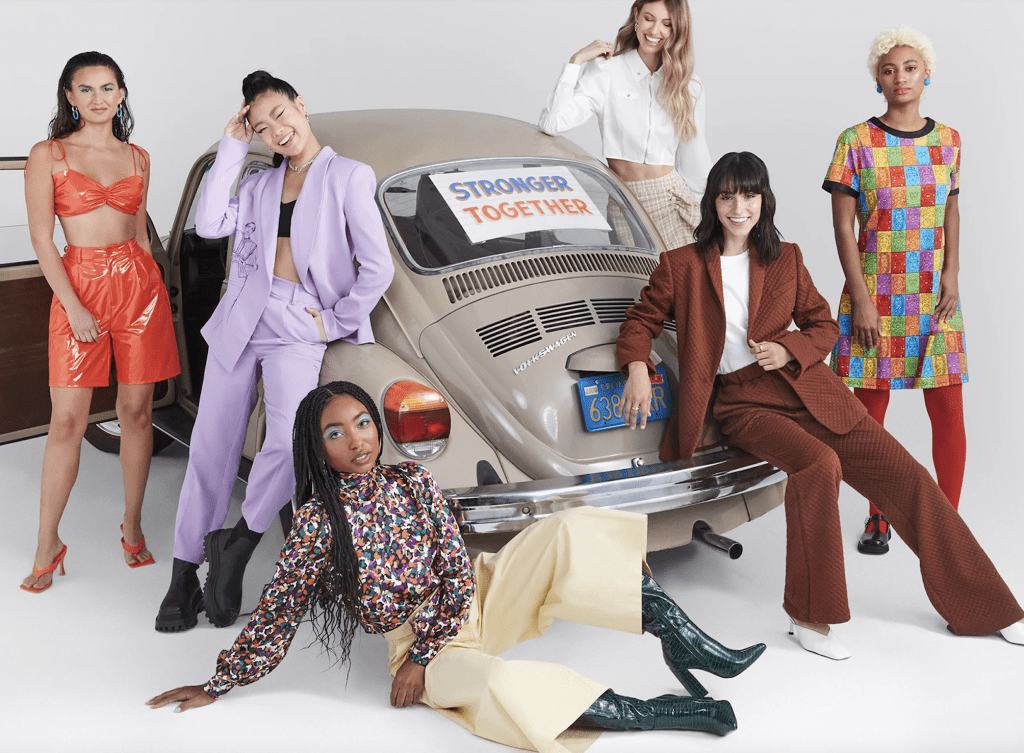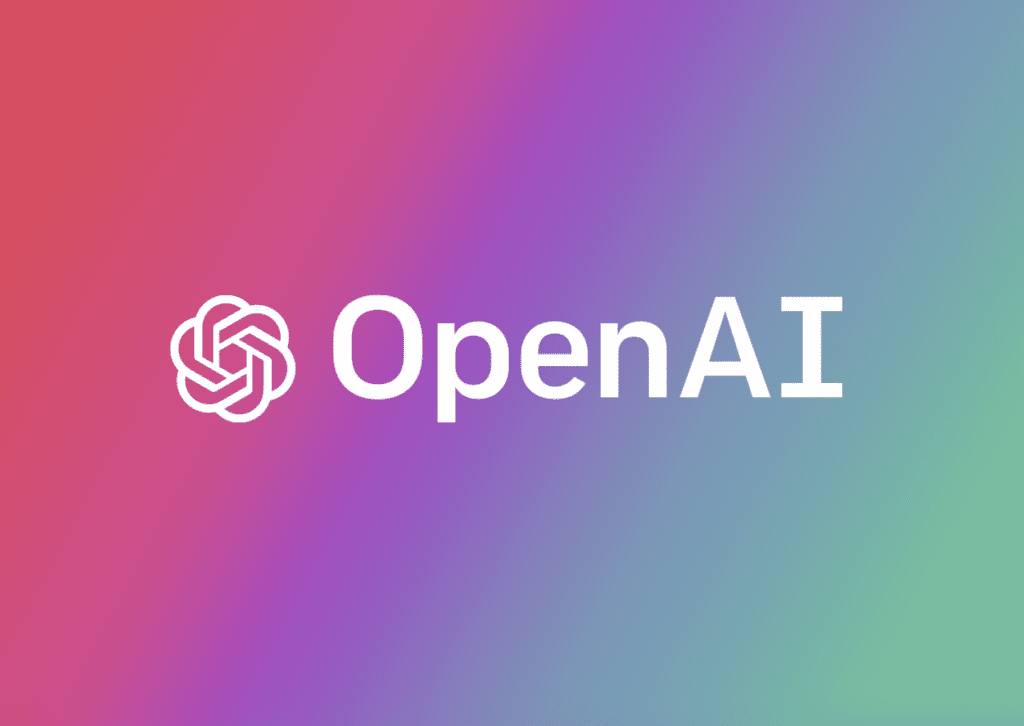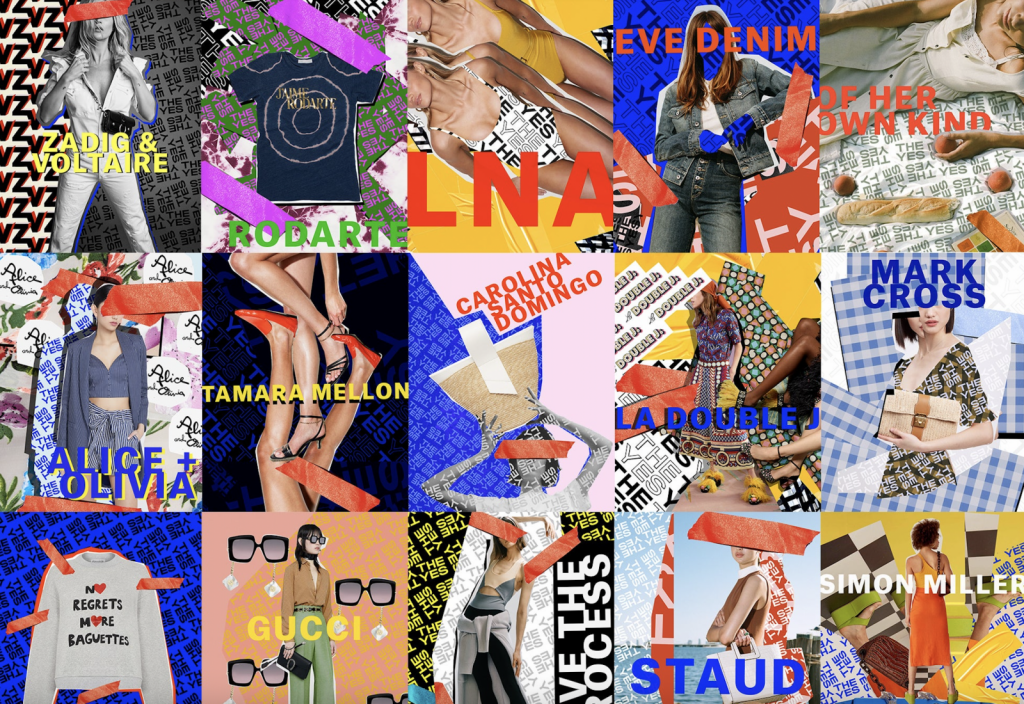Ferrari revealed on Monday that it has entered into a multi-year deal with Swiss technology firm Velas Network to create digital content for fans of Scuderia Ferrari, the company’s racing division. Boasting an “ecosystem of decentralized products that allow anyone to feel the benefits of blockchain technology” and of course, the metaverse more broadly, Velas will also become a “Title Sponsor of the Ferrari Esports Series, the online mono-brand series of the Prancing Horse, and of the Esports team that will compete in the F1 Esports Series, the official digital championship competed in by all teams participating in the FIA Formula 1 World Championship,” Ferrari said in a statement.
The Maranello, Italy-based automaker is the latest luxury name to venture into the virtual world, as interest in the metaverse – i.e., the digital universe in which users can engage by way of a combination of tech advancements, including virtual reality, augmented reality and video – and assets like non-fungible tokens (or “NFTs”) as surged over the past several months, in particular. As companies – ranging from luxury brands to sportswear giants like Nike and adidas – continue to race to connect with and market to consumers in the budding digital world, questions of authenticity, valuation, and scale have come about and are developing in real time.
With that in mind, we take a look at some of the top metaverse-related stories of 2021, which give us insight into what happened this year and what we can expect in the year ahead …
NFTs: What Are You Buying and What Do You Actually Own?
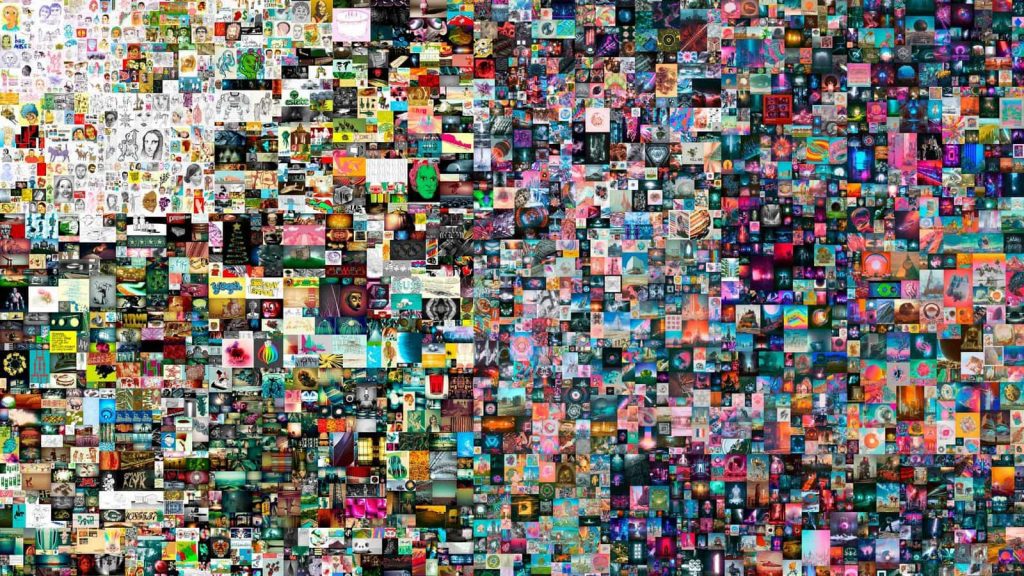
Ownership of an NFT as a unique token – versus ownership of the content that such NFT may be associated with – is a critical distinction. When someone purchases an NFT tied to a piece of content, they have not automatically purchased the underlying intellectual property rights in such piece of content. Under Section 106 of the U.S. Copyright Act, a copyright owner has certain exclusive rights to reproduce, prepare derivative works of, perform, display, and distribute the copyrighted work.
As a general rule, the purchase of a piece of art does not transfer all copyright in such work to the buyer. For example, when someone buys a painting at an art gallery for their home, they are acquiring the physical painting itself, which they can display, but not the underlying rights to reproduce, make derivative works of, or distribute copies of such painting.
Where Exactly Does the Value of NFTs Come From?
When you pay for an NFT, what you get is the right to transfer the token to your digital wallet. The token proves that your copy of a digital file is the original, like owning an original painting. And just as masterpiece paintings can be copied and distributed as inexpensive posters, anyone can have a digital copy of your NFT. Your private crypto key is proof of ownership of the original. The content creator’s public crypto key serves as a certificate of authenticity for that particular digital artifact, and together, the pairing of the creator’s public key and the owner’s private key is what determines some of the value of any NFT token.
From a non-technical perspective, a notable amount of the value of NFTs comes from the element of rarity at play, as well as the sheer hype associated with the budding asset class.
From Baby Birkins to MetaBirkins, Brands Are Facing Issues in the Metaverse
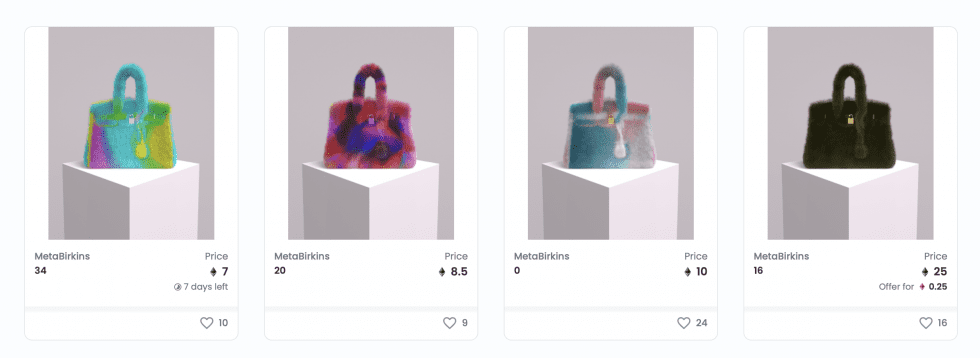
Hermès’ Birkin bags are swiftly becoming the posterchild of the increasingly widespread – and unauthorized – use of brands’ valuable assets in the metaverse. The French luxury goods brand spoke out this month, asserting that it “did not authorize nor consent to the commercialization or creation” of 100 virtual Birkin bag-centric non-fungible tokens (“NFTs”) that artist Mason Rothschild has been offering up. A rep for Hermès said that Rothschild’s “MetaBirkins” NFTs “infringe upon [its] trademark rights, and are an example of fake Hermès products in the metaverse.” Hermès’ statement follows from Mr. Rothschild touting the success of the MetaBirkins, including the sale of the very first one for roughly $40,000 in Ether and total sales of almost $800,000 as of earlier this month.
Interestingly enough, Hermès is not the only one being copied in this equation. In an interview on December 6, Rothschild shed light on the proliferation of “fake” versions of his allegedly infringing NFT, saying that before he actually made the MetaBirkins available for purchase on OpenSea, “a bunch of counterfeit [MetaBirkins] that were not from my collection” appeared on the NFT marketplace.
Branding in the Metaverse: The Future of Virtual Goods Trademarks
Nike made headlines in November after filing a number of intent-to-use trademark applications in the U.S. and beyond for its most famous trademarks – such as its “Nike,” “Just Do It,” and “Jordan” word marks, its iconic swoosh logo, the Jordan silhouette logo, and a stylized combination of its name and the swoosh – for use on various virtual goods/services. Specifically, the applications suggested – and its subsequent launch of the Roblox-hosted Nikeland experience and acquisition of virtual footwear and fashion brand RTFKT confirmed – that Nike was looking to get into the metaverse and fast.
While Nike is an early-mover both in terms of its entrance into the metaverse (it first partnered with Roblox back in 2019 and with video game-makers before that) and in terms of its trademark filings, the Swoosh is not the only trademark that is going to populate the growing metaverse. Brands ranging from sportswear giants to luxury goods purveyors like Balenciaga and Gucci are readily considering – and in some cases, actively testing – how they can use the metaverse to connect with consumers and generate revenue.
As NFTs Continue to Find a Home in Fashion, the GDPR Poses Some Tensions for Brands
One legal angle that has not been considered with too frequency to date is what the General Data Protection Regulation (“GDPR”) means for the burgeoning field of NFTs. Implemented across the European Union in May 2018, the GDPR is a sweeping privacy and security law that requires businesses to “protect the personal data and privacy of EU citizens for transactions that occur within EU member states.” Since the GDPR is “technologically neutral, which means that compliance must be ensured whenever personal data of natural persons is processed in a structured manner, and given that “the material scope of the GDPR is also applicable to the blockchain whenever personal data of a natural person is processed,” brands need to ensure that they are in compliance with the robust privacy law in furtherance of their practice of offering up NFTs.
From the Baby Birkin to Virtual Fashion, Digital Offerings are Creating New Legal Issues

One need not look further than popular NFT auction platform Open Sea to observe the frequency with which NFT creators are looking to famous brands and their trademarks in a commercial capacity, often without authorization. From digital versions of things like the collaborative box logo that came by way of Louis Vuitton’s collaboration with Supreme to NFTs associated with physical luxury goods, such as a Louis Vuitton x Supreme backpack (which may or may not be authentic).
As Orrick’s Sheryl Koval Garko, Mark Puzella, and Caroline Simons note, “Minting tools and NFT tutorials are now widely available on the internet, meaning that anyone could conceivably turn a file into an NFT.” The accessibility of the NFT-making market paired with the broader embrace of – and demand for – digital fashion items, particularly by Gen-Z consumers, has seemingly opened the door to those looking to trade on the well-established goodwill of famous fashion brands, and in the process, are presenting brands with an entirely new market to police when it comes to potential instances of infringement.
What Does the Law Look Like in the Metaverse?
The centralized architecture of cyberspace means that governing bodies can enforce the rules of law against online companies. Shifting our commercial and social activities into a mixed reality would pit the physical world – where our established legal orders exist and normatively prevail – against the virtual world, which is the realm of code. As such, the shift of our economic and societal functions towards virtuality (on the reality – virtuality continuum) will require a robust response from lawmakers.
From Royalties to Resale Restrictions, What Would Tying NFTs to Luxury Goods Look Like?
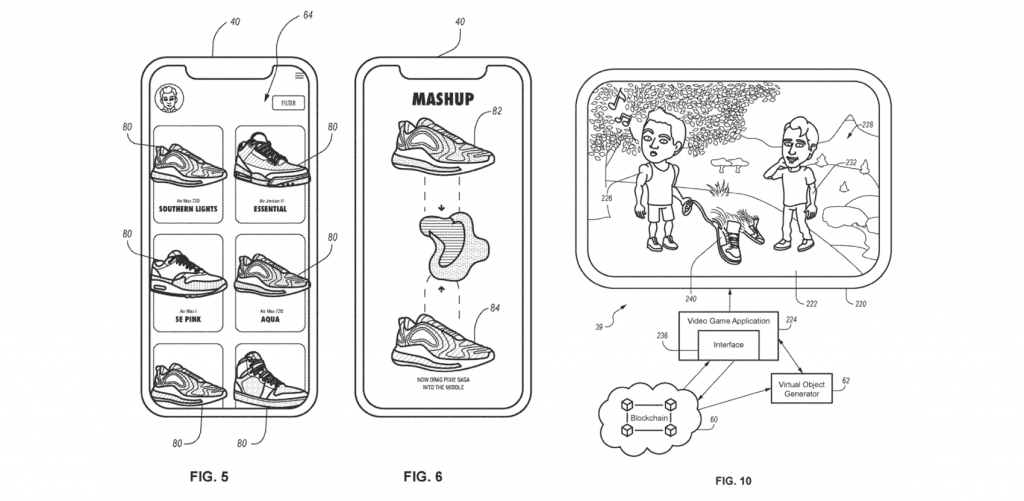
In addition to tying an individual NFT to a specific digital asset, such as a Beeple artwork or a digital dress like the one that The Fabricant created in 2019, brands are going a step further and “creating NFTs that represent actual clothing” or in Nike’s case, could be tied to real-world sneakers. While “the tokenization of physical items is not yet as developed as their digital counterparts,” blockchain platform Ethereum states in a “use case” report that NFTs “can be used to represent ownership of any unique asset in the digital or physical realm,” and asserts that “there are plenty of projects exploring the tokenization of real estate, one-of-a-kind fashion items, and more.”
LVMH, Richemont, Prada Team Up for New Blockchain Venture
In May 2019, LVMH Moët Hennessy Louis Vuitton made headlines when it announced that it was working on something big in the blockchain space: Aura, a platform that it said would “serve the entire luxury industry with powerful product tracking and tracing services, based on Ethereum blockchain technology and utilizing Microsoft’s [cloud computing service] Azure.” In the two years since LVMH’s revelation, the Paris-based group’s marquee brand Louis Vuitton has been quietly working to link a “very significant” number of new products to blockchain-hosted digital certificates of authenticity that exist alongside those physical goods and give consumers insight into the providence of the products.
At the same time, in a nod to LVMH’s vow that it would make the system available to other industry entities (for a licensing fee), Prada Group revealed in April that it is using LVMH’s technology, and in October, Diesel owner OTB – which recently launched a new business unit dedicated to the development of products, projects and experiences designed for the metaverse – announced that it had has joined as a new founding member of the Aura Blockchain Consortium.
Kering Brands Are Looking to the Metaverse With Partnerships, Trademark Filings
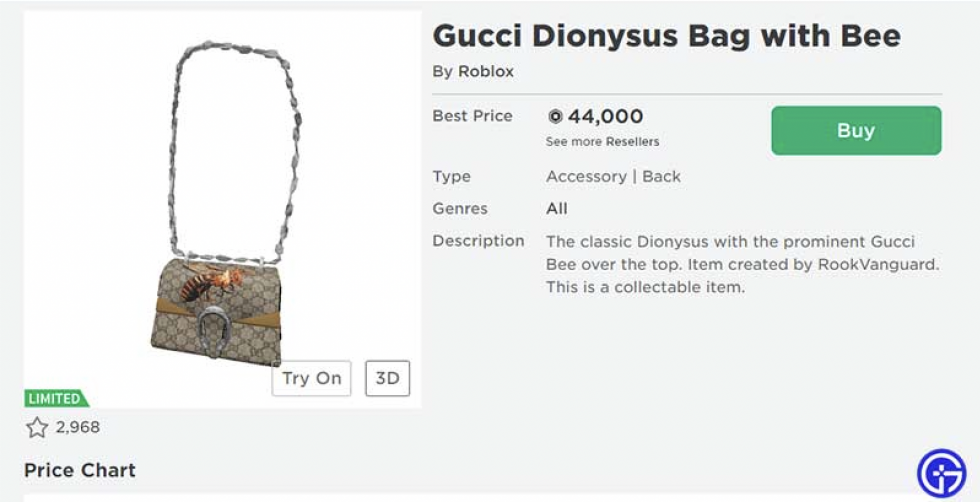
Kering brands want in on the metaverse. It may early days when it comes to the budding shift towards a virtual reality but nonetheless, some of fashion and luxury’s biggest names appear to be looking to reach consumers in this medium by way of collaborations with companies in the virtual reality, augmented reality, blockchain, and gaming space, as well as through their own ventures.
Some of the brands that fall under Kering’s umbrella are among those that have been at the forefront of the move to the metaverse, with the French luxury goods group’s marquee label Gucci, for instance, garnering no shortage of consumer attention this spring when it launched its “Gucci Garden” experience on Roblox. Thanks to Gucci’s virtual pop-up in the Roblox universe in May, Roblox’s user base could “immerse themselves into [Gucci creative director] Alessandro Michele’s creative vision and his multifarious inspirations, and share the captivating experience of the exhibition with their friends.” At the same time, they could, of course, win or purchase, and then wear exclusive Gucci virtual items.
Meanwhile, Kering-owned Balenciaga announced in December that it is rolling out a division to further explore the avenues provided by the virtual world.
Chanel President Says It May Make Metaverse Move
Asked about the company’s adoption of various new technologies, president of fashion Bruno Pavlovsky said Chanel is looking both at NFTs and at the metaverse: “Three years ago, everyone spoke of blockchain, and now we are using it throughout our entire manufacturing process. The day we are ready we will come with our own contribution to the metaverse.” It is not unreasonable to expect that Chanel will at some point roll out a proprietary metaverse venture in which it will maintain control over all aspects given the meticulousness with which it endeavors to handle all elements of the manufacturing and distribution chain for its products, including in a secondary market capacity.
As NFT Marketplaces Race to Meet Demand, What Are the Legal Issues?
Amid the rise of NFTs, marketplaces are launching specifically to capitalize on this growing demand for buying and selling NFTs. But given that NFTs are still relatively new, regulation in this area is still evolving. Given the quickly-changing nature – and the readily-growing size – of the NFT market, it is paramount to understand all the legal considerations when launching an NFT marketplace, including documentation, intellectual property, and other legal concerns, as well as overarching legal implications of this new technology.




